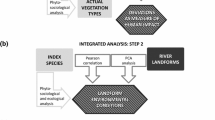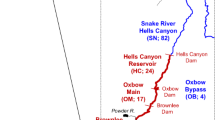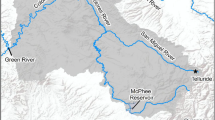Abstract
The Missouri River and the Platte River provide opposite examples of the way riparian vegetation responds and adjusts to regulation by dams and diversions.Populus-Salix woodland has expanded rapidly into Platte River channels, while it has failed to regenerate in gaps between reservoirs along the upper Missouri River. This divergent response is the result of different geomorphologies and water-use patterns. The Platte River is a braided-type stream with a significant portion of its flow diverted for cropland irrigation. The Missouri is a meandering-type stream with low irrigation usage. I developed a graphical model that characterizes the different ways that riparian vegetation has adjusted to regulation. The model identifies two time periods: pre-regulation and post-regulation adjustment, with the latter divided into phase 1 and phase 2 subperiods. In the pre-regulation period, woodland composition shifts according to weather extremes and climate change. During phase 1, braided rivers adjust by channel-narrowing and expansion of pioneer woodland (Populus-Salix), while meandering rivers cease meandering. During phase 2, after major geomorphic adjustments are complete, both types of rivers, show sharp declines in pioneer woodland Replacement communities in the new equilibrium (post-adjustment period) will be dominated by later successional woodland or grassland species. Geomorphic factors of importance to vegetation establishment adjust relatively quickly (decades), but the subsequent adjustment of vegetation through succession is relatively slow (century or more).
Similar content being viewed by others
Literature Cited
Boggs, K. and T. Weaver. 1994. Changes in vegetation and nutrient pools during riparian succession. Wetlands 14:98–109.
Bormann, F. H. and G. E. Likens. 1979. Catastrophic disturbance and the steady state in northern hardwood forests. American Scientist 67:660–669.
Bradley, C. E. and D. G. Smith. 1986. Plains cottonwood recruitment and survival on a prairie meandering river floodplain, Milk River, southern Alberta and northern Montana. Canadian Journal of Botany 64:1433–1442.
Bradley, C., F. Reintjes, and J. Mahoney (eds.). 1991. The Biology and Status of Riparian Poplars in Southern Alberta. World Wildlife Fund Canada and Alberta Fish and Wildlife Division, Forestry, Lands and Wildlife, Government of Alberta, Canada.
Bragg, T. B. and A. K. Tatschl. 1977. Changes in flood-plain vegetation and land use along the Missouri River from 1826 to 1972. Environmental Management 1(4):343–348.
Busch, D. E. and S. D. Smith. 1995. Mechanisms associated with decline of woody species in riparian ecosystems of the southwestern U. S. Ecological Monographs 65:347–370.
Church, M. 1995. Geomorphic response to river flow regulation: case studies and time-scales. Regulated Rivers: Research and Management 11:3–22.
Crouch, G. L. 1979. Changes in the vegetation complex of a cottonwood ecosystem on the South Platte River. p. 19–22.In Great Plains Agricultural Council. Proceedings of the 31st Annual Meeting. Colorado State University, Fort Collins, CO, USA. Great Plains Ag. Council Publication No. 91.
Decamps, H., M. Fortune, F. Gazelle, and G. Pautou. 1988. Historical influence of man on the riparian dynamics of a fluvial landscape. Landscape Ecology 1:163–173.
Eschner, T. R., R. F. Hadley, and K. D. Crowley. 1983. Hydrologic and morphologic changes in channels of the Platte River Basin in Colorado, Wyoming, and Nebraska: a historical perspective. United States Geological Survey Professional Paper 1277-A.
Everitt, B. L. 1968. Use of the cottonwood in an investigation of the recent history of a flood plain. American Journal of Science 266:417–439.
Everitt, B. L. 1980. Ecology of salteedar—a plea for research. Environmental Geology 3:77–84.
Everitt, B. L. 1993. Chennel responses to declining flow on the Rio Grande between Ft. Quitman and Presidio, Texas. Geomorphology 6:225–242.
Friedman, J. M., W. R. Osterkamp, and W. M. Lewis, Jr. 1996. Channel narrowing and vegetation development following a Great Plains flood. Ecology 77:2167–2181.
Friedman, J. M., M. L. Scott, and G. T. Auble. 1997. Water management and cottonwood forest dynamics along prairie streams. p. 49–71.In F. L. Knopf and F. B. Samson (eds.) Ecology and Conservation of Great Plains Vertebrates. Springer-Verlag, New York, NY, USA.
Friedman, J. M., W. R. Osterkamp, M. L. Scott, and G. T. Auble. 1998. Regional pattern in response of riparian forest to water management in the Great Plains. Wetlands 18:619–633.
Gerlek, S. 1977. Water supply management analysis and alternative development for the South Platte River basin. Volume 2. United States Army Corps of Engineers, Omaha, NE, USA.
Grimm, E. C. 1984. Fire and other factors controlling the Big Woods vegetation of Minnesota in the mid-nineteenth century. Ecological Monographs 54:291–311.
Hadley, R. F., M. R. Karlinger, A. W. Burns, and T. R. Eschner. 1987. Water development and associated hydrologic changes in the Platte River, Nebraska. USA. Regulated Rivers: Research and Management 1:331–341.
Hesse, L. W. 1996. Floral and faunal trends in the middle Missouri River. p. 73–90.In D. L. Galat and A. G. Frazier (eds.) Overview of river-floodplain ecology in the upper Mississippi River basin. Vol. 3 of J. A. Kelmelis (ed.) Science for Floodplain Management into the 21st Century. U. S. Government Printing Office, Washington, DC, USA.
Hughes, F. M. R. 1994. Environmental change, disturbance and regeneration in semi-arid floodplain forests. p. 321–345.In A. C. Millington and K. Pye (eds.) Environmental Change in Drylands: Biogeographical and Geomorphological Perspectives. John Wiley & Sons Ltd., Chichester, England.
Johnson, W. C., R. L. Burgess, and W. R. Keammerer. 1976. Forest overstory vegetation and environment on the Missouri River floodplain in North Dakota. Ecological Monographs 46:59–84.
Johnson, W. C. 1992. Dams and riparian forests: case study from the upper Missouri River. Rivers 3:229–242.
Johnson, W. C. 1994. Woodland expansion in the Platte River, Nebraska: patterns and causes. Ecological Monographs 64:45–84.
Johnson, W. C. 1997. Equilibrium response of riparian vegetation to flow regulation in the Platte River, Nebraska. Regulated Rivers: Research and Management 13:403–415.
Little, E. L., Jr. 1971. Atlas of United States trees, Volume 1. Conifers and important hardwoods. U. S. D. A.-Forest Service, Washington, DC, USA. Misc. Publ. No. 1146.
Malanson, G. 1993. Riparian Landscapes. Cambridge University Press, Cambridge, England.
McBride, J. R. and J. Strahan. 1984. Establishment and survival of woody riparian species on gravel bars of an intermittent stream. American Midland Naturalist 112:235–245.
McIntosh, R. P. 1962. The forest cover of the Catskill Mountain Region, New York, as indicated by land survey records. American Midland Naturalist 68:409–423.
McKinley, J. L. 1938. The influence of the Platte River upon the history of the valley. Burgess, Minneapolis, MN, USA.
Moss, E. H. 1938. Longevity of seed and establishment of seedlings in species ofPopulus. Botanical Gazette 99:529–542.
Nadler, C. T. and S. A. Schumm. 1981. Metamorphosis of the South Platte and Arkansas Rivers, eastern Colorado. Physical Geography 2:95–115.
Noble, M. G. 1979. The origin ofPopulus deltoides andSalix interior zones on point bars along the Minnesota River. American Midland Naturalist 102:59–67.
Ohmart, R. D., B. W. Anderson, and W. C. Hunter. 1988. The ecology of the lower Colorado River from Davis Dam to the Mexico-United States International Boundary: A community profile. U. S. Department of the Interior, Washington, DC, USA. Biological Report 85(7.19).
Petts, G. E. 1984. Impounded Rivers. Wiley and Sons Ltd., Chichester, England.
Petts, G. E. 1987. Time-scales for ecological change in regulated rivers. p. 257–266.In J. F. Craig and J. B. Kemper (eds.) Regulated Streams: Advances in Ecology. Plenum Press, New York, NY, USA.
Reily, P. W. and W. C. Johnson. 1982. The effects of altered hydrologic regime on tree growth along the Missouri River in North Dakota. Canadian Journal of Botany 60:2410–2423.
Rood, S. B. and J. M. Mahoney. 1990. The collapse of river valley forests downstream from dams in the western prairies: probable causes and prospects for mitigation. Environmental Management 14:451–464.
Rood, S. B. and J. M. Mahoney. 1995. River damming and riparian cottonwoods along the Marias River, Montana. Rivers 5:195–207.
Russell, E. W. B. 1981. Vegetation of northern New Jersey before European settlement. American Midland Naturalist 105:1–12.
Russell, E. W. B. 1983. Indian-set fires in the forests of the northeastern United States. Ecology 64:78–88.
Schumm, S. A. and D. F. Meyer. 1979. Morphology of alluvial rivers of the Great Plains. p. 9–14.In Great Plains Agricultural Council. Proceedings of the 31st Annual Meeting. Colorado State University, Fort Collins, CO, USA. Great Plains Ag. Council Publication no. 91.
Scott, M. L., G. T. Auble, and J. M. Friedman. 1997. Flood dependency of cottonwood establishment along the Missouri River, Montana, USA. Ecological Applications 7:677–690.
Snyder, W. D. and G. C. Miller. 1991. Changes in plains cottonwoods along the Arkansas and South Platte Rivers-eastern Colorado. Prairie Naturalist 23:165–176.
Stanford, J. A. and J. V. Ward. 1979. Stream regulation in North America, p. 215–236.In J. V. Ward and J. A. Stanford (eds.) The Ecology of Regulated Streams. Plenum Press, New York, NY, USA.
Stanford, J. A., J. V. Ward, W. J. Liss, C. A. Frissell, R. N. Williams, J. A. Lichatowich, and C. C. Coutant. 1996. A general protocol for restoration of regulated rivers. Regulated Rivers: Research and Management 12:391–413.
Stearns, F. W. 1949. Ninety years of change in a northern bardwood forest in Wisconsin. Ecology 30:350–358.
Turner, R. M. 1974. Quantitative and historical evidence of vegetation changes along the Upper Gila River, Arizona. United States Geological Survey Professional Paper 655-H.
Turner, R. M. and M. M. Karpiscak. 1980. Recent vegetation changes along the Colorado River between Glen Canyon Dam and Lake Mead, Arizona. United States Geological Survey Professional Paper 1132.
United States Bureau of Reclamation. 1982. Water use and management in the Upper Platte River Basin in Colorado-Wyoming-Nebraska. Department of the Interior, Washington, DC, USA.
Williams, G. P. and M. G. Wolman. 1984. Downstream effects of dams on alluvial rivers. United States Geological Survey Professional Paper 1286.
Author information
Authors and Affiliations
Rights and permissions
About this article
Cite this article
Johnson, W.C. Adjustment of riparian vegetation to river regulation in the Great Plains, USA. Wetlands 18, 608–618 (1998). https://doi.org/10.1007/BF03161676
Received:
Revised:
Accepted:
Issue Date:
DOI: https://doi.org/10.1007/BF03161676




